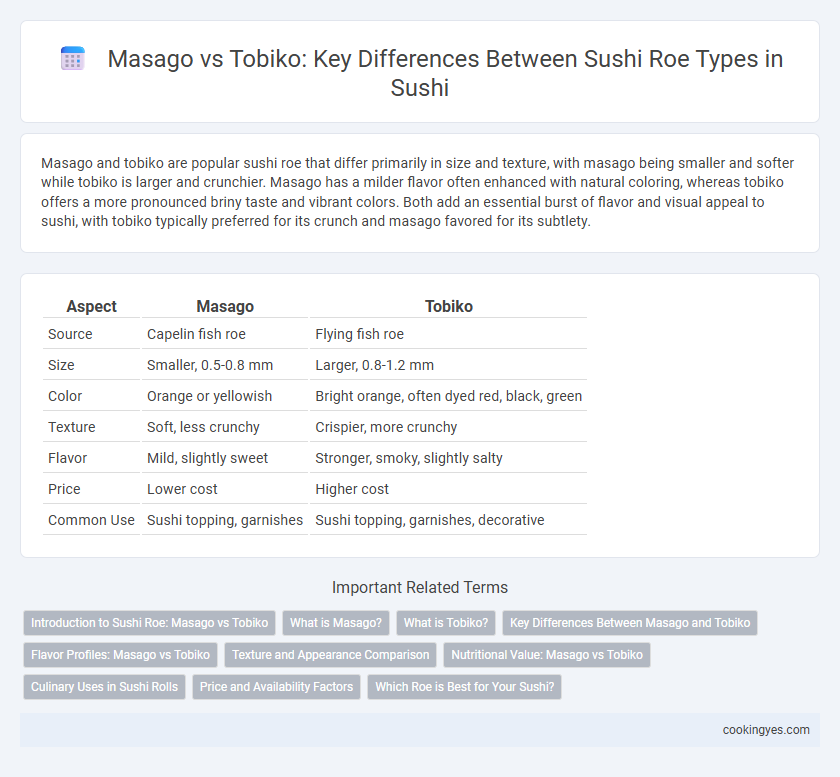Masago and tobiko are popular sushi roe that differ primarily in size and texture, with masago being smaller and softer while tobiko is larger and crunchier. Masago has a milder flavor often enhanced with natural coloring, whereas tobiko offers a more pronounced briny taste and vibrant colors. Both add an essential burst of flavor and visual appeal to sushi, with tobiko typically preferred for its crunch and masago favored for its subtlety.
Table of Comparison
| Aspect | Masago | Tobiko |
|---|---|---|
| Source | Capelin fish roe | Flying fish roe |
| Size | Smaller, 0.5-0.8 mm | Larger, 0.8-1.2 mm |
| Color | Orange or yellowish | Bright orange, often dyed red, black, green |
| Texture | Soft, less crunchy | Crispier, more crunchy |
| Flavor | Mild, slightly sweet | Stronger, smoky, slightly salty |
| Price | Lower cost | Higher cost |
| Common Use | Sushi topping, garnishes | Sushi topping, garnishes, decorative |
Introduction to Sushi Roe: Masago vs Tobiko
Masago and tobiko are popular types of sushi roe used to enhance texture and flavor in sushi dishes, with masago derived from capelin fish and tobiko from flying fish. Masago features smaller, finer eggs with a mild, slightly sweet taste and vibrant orange hue, while tobiko eggs are larger, crunchier, and have a more pronounced smoky flavor and bright red-orange color. Both roe varieties deliver nutritional benefits such as omega-3 fatty acids and protein, contributing to the authentic sushi experience.
What is Masago?
Masago is the roe of the capelin fish, commonly used in sushi for its small, crunchy texture and mild, slightly sweet flavor. It typically appears bright orange and adds a delicate pop to dishes like sushi rolls and nigiri. Masago is often preferred for its affordability and subtle taste compared to other fish eggs like tobiko.
What is Tobiko?
Tobiko is the roe of flying fish, prized in sushi for its vibrant orange color, crunchy texture, and mildly smoky flavor. It is smaller than masago (capelin roe) and often used as a garnish to add both visual appeal and a burst of umami to sushi rolls. Rich in protein and omega-3 fatty acids, tobiko enhances dishes with its distinct pop and subtle brininess.
Key Differences Between Masago and Tobiko
Masago and Tobiko are both popular types of fish roe used in sushi, with Masago being the eggs of the Capelin fish and Tobiko coming from flying fish. Tobiko eggs are larger, crunchier, and have a slightly smoky flavor, while Masago eggs are smaller, softer, and milder in taste. Nutritionally, Tobiko contains more protein and omega-3 fatty acids, making it a richer choice for sushi toppings.
Flavor Profiles: Masago vs Tobiko
Masago and Tobiko offer distinct flavor profiles for sushi roe, with Masago presenting a mild, slightly sweet taste and a softer texture, while Tobiko delivers a more robust, crunchy texture accompanied by a smoky, salty flavor. Masago's subtle flavor enhances sushi without overpowering other ingredients, making it ideal for delicate rolls. Tobiko's bolder taste and pronounced crunch add a dynamic contrast, often used to elevate sashimi and specialty rolls with its vibrant pop and complexity.
Texture and Appearance Comparison
Masago, or capelin roe, features smaller, finer eggs with a softer, slightly crunchy texture, creating a delicate mouthfeel in sushi dishes. Tobiko, flying fish roe, displays larger eggs with a more robust crunch and a vibrant, glossy appearance ranging from bright orange to red, enhancing both taste and visual appeal. The distinct texture and vivid coloration of tobiko make it a popular choice for adding bold contrast, while masago provides subtler texture and color complementing more delicate sushi presentations.
Nutritional Value: Masago vs Tobiko
Masago, derived from capelin fish eggs, is lower in calories and fat but higher in carbohydrates compared to tobiko, which comes from flying fish roe. Tobiko provides more protein and omega-3 fatty acids, enhancing its nutritional profile with essential nutrients. Both types of sushi roe are rich in vitamins B12 and selenium, promoting brain health and antioxidant protection.
Culinary Uses in Sushi Rolls
Masago, derived from capelin fish, offers a smaller, finer texture and a milder flavor, making it ideal for adding subtle crunch and color in sushi rolls like California rolls. Tobiko, sourced from flying fish, provides larger, crunchier beads with a slightly smoky and salty taste, enhancing the sensory experience in specialty rolls such as Dragon or Rainbow rolls. Both roe types bring unique visual appeal and texture variations, with masago preferred for its versatility and tobiko favored for bold flavor contrasts.
Price and Availability Factors
Masago, harvested from capelin fish, is generally more affordable and widely available than tobiko, which comes from flying fish roe and is considered a premium ingredient. The smaller size and milder flavor of masago make it a cost-effective choice for sushi chefs aiming to maintain quality while managing expenses. Tobiko's vibrant color and distinctive crunch contribute to its higher market price and less frequent availability in some regions.
Which Roe is Best for Your Sushi?
Masago, the small, crunchy roe from capelin fish, offers a milder flavor and vibrant orange color, making it ideal for adding texture without overpowering the sushi's taste. Tobiko, derived from flying fish, features larger eggs with a distinctive crunch and a more pronounced, slightly sweet flavor profile, often enhanced with natural coloring like wasabi or squid ink for variety. Choosing between masago and tobiko depends on whether you prefer subtle texture and taste or bold flavor and visual impact for your sushi creation.
Masago vs Tobiko for Sushi Roe Infographic

 cookingyes.com
cookingyes.com